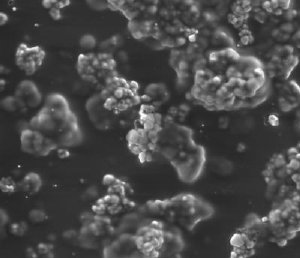Jan 24 2010
When University of Utah scientists discovered a new kind of laser that was generated by an electrically conducting plastic or polymer, no one could explain how it worked and some doubted it was real. Now, a decade later, the Utah researchers have found these "random lasers" occur because of natural, mirror-like cavities in the polymers, and they say such lasers may prove useful for diagnosing cancer.
 This microscope view of a film of the polymer DOO-PPV shows clumps of undissolved polymer power within the darker dissolved polymer material. Such irregularities are believed to create the tiny cavities that act as built-in, mirror-like resonators to produce what is known as "random laser" light, according to a new University study. Credit: Randy Polson, University of Utah.
This microscope view of a film of the polymer DOO-PPV shows clumps of undissolved polymer power within the darker dissolved polymer material. Such irregularities are believed to create the tiny cavities that act as built-in, mirror-like resonators to produce what is known as "random laser" light, according to a new University study. Credit: Randy Polson, University of Utah.
"Nobody knew how it worked until now," says Z. Valy Vardeny, a distinguished professor of physics and senior author of the new study, published online Sunday, Jan. 24 in the journal Nature Physics. "We succeeded in imaging the cavities. This is a big step in our understanding of this bizarre phenomenon, which not many people believed."
Materials or "gain media" that generate conventional lasers are put in an ordered structure known as "lossless resonators" – often mirrors – that generate light without losing much of it. Random laser materials, in contrast, are disordered and lose some light.
Or as Vardeny puts it: "You can get lasing out of junky materials if they contain molecules that glow. Out of disorder comes perfect order."
In the new study, Vardeny and colleagues created images to reveal the natural cavities within a "pi-conjugated polymer film," which is a thin film of an organic polymer – named DOO-PPV – that conducts electricity even though it is a plastic-like material. ("Pi-conjugated" refers to the material's electronic structure.)
The microscopic cavities – natural irregularities within the plastic – act together like the mirrors in regular resonators that help amplify the light in a conventional laser.
Lasers "are carefully designed and constructed to produce laser emission," says study coauthor Randy Polson, a senior optical engineer at the University of Utah's Dixon Laser Institute. "Surprisingly, there is a class of lasers where laser emission happens from materials that are literally shaken together. These are called random lasers since the emission happens from an uncontrolled configuration" – a disordered rather than crystal structure within the "lasing medium" – the material used to generate the laser.
"There has been some disagreement how random lasers operate. For an analogy, imagine you are outside a sports stadium and hear the roar of the crowd. Is the noise initiated throughout the stadium at the same time (led by cheerleaders shouting 'Go! go!'), or are people yelling on their own ('Great catch,' 'Yea!')?"
"Our work has shown that the emission from random lasers happens with one emitter at a time, like individuals in the crowd yelling unconnected shouts," Polson says.
Vardeny and Polson conducted the study with first author Abdullah Tulek, who now works in Turkey but was a University of Utah doctoral student at the time. The study was funded by the U.S. Department of Energy and the National Science Foundation.
The New Study: Order within a Disordered Material
In conventional lasers, cavities are created by carefully placing mirrors around the medium that contains the chromophore material, be it a crystal, gas or dye, Vardeny says. The new study shows random lasers have tiny, built-in, natural mirrors, he adds. To make pictures of laser-generating cavities within the DOO-PPV polymer, the scientists focused a green, conventional laser pulse on a thin film of the polymer, stimulating red random laser emission from the film. By focusing a lens in a certain way, they made 10,000 images of the red laser light spectrum emitted by microscopic squares within the film, then assembled them into an image of the entire piece of polymer film.
They revealed the mirror-like cavities by showing adjacent pixels with the same red light spectrum and the same above-average index of refraction, which is a measure of how fast light travels within a material. When they mapped areas of above-average refraction index within the DOO-PPV polymer, those areas were connected to form loops, which act as mirror-like cavities to generate laser light, Vardeny says.
The Utah researchers used what is known as a "Fourier transform" to analyze the wave pattern from the DOO-PPV random laser. Polson cites an analogy: If you strum a guitar, and then use a Fourier transform to analyze the sound waves, you can figure out what strings or notes were played at any moment.
In a similar manner, the researchers transformed the light wave patterns for various spots on the polymer, and that revealed there were cavities within the material.
Random Lasing Could Automate Tissue Analysis for Cancer
Vardeny and his colleagues now are conducting more research aimed at developing and commercializing random lasers to distinguish cancerous from noncancerous human tissue. In a 2004 study in Applied Physics Letters, they infused human colon tissue – normal and tumor – with a red fluorescent dye that generates random laser light when stimulated.
They could distinguish tumor from normal colon tissue because the tumor emitted more individual lines of random laser light, possibly because its structure was more disordered than normal tissue.
"The disorder in cancerous tissue is much more chaotic than that in a benign tissue," says Vardeny.
Pathologists now look for abnormalities that indicate cancer, but Vardeny says the random lasing method has potential for automating tissue examinations for cancer.